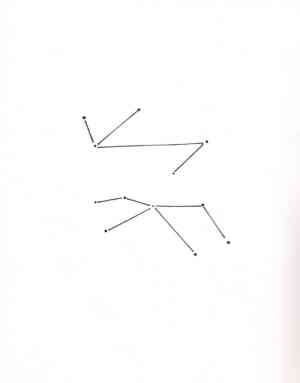Imagining Space

Digital art is exciting! It conquers a future-forward so non-defined, yet currently definitive for progress sub-space, the virtual. Our experience in virtual space is still relatively new compared to our experience in physical space. We are just beginning to find ways to understand this space as part of our reality. We are also still exploring its extension, impact, and character. Before the actual things within any space can be discussed, the space itself needs to be defined and the definitions agreed upon. How we define space itself will decide how we define the elements within the space. How we define space will decide what the elements within the space will look like and what they will be capable of.
Science and Myths
From the start, science was intrinsically linked to tool making, reasoning, the human experience, and its other products such as culture, myths, and religions.
By today sciences have developed strict protocols, conventions, definitions, instruments, methods, and languages to demarcate itself from “mere beliefs” and to instead advance knowledge. Sciences are products of human experience, and human thinking but are generally understood to be independent of human touch and emotion. In their daily practice, most scientists do not seem to think much about the type of impact of human design on scientific research. Their focus lies on producing results, which are repeatable and can be made consistent with existing theory.
Questioning the role of the human mind and its contribution to our creation of truth becomes the subject of philosophical research. How are our old passed-on beliefs and stories reflected in contemporary science? Given that technology is built based on science: How are these beliefs translated into the technology we build? When defining something, how do old beliefs affect how we think it?




Our State of Modernism
The first cars looked similar to carriages and our computer’s desktop and folders are still designed like and called “desktop” and “folder”. How can we cut the process of mis-designing the future short?
To keep our past culture out of creating new worlds as much as possible, we need to understand where it comes from and why it became what it is. Then we can define alternative shapes of spaces and processes.
New technologies, such as virtual and augmented reality, blockchain, and shared 3d virtual environments are created at an increasing tempo. How do we design media and its content in a way that it uses the full potential of those new technologies - instead of reproducing and translating what we already have in the physical world into the digital? Unbeknownst that the elements we translate into the digital stem from analog systems and therefore make sense in the analog world, but are falling behind as solutions for digital environments. And of course, we see ourselves as modern, enlightened, and mostly rational people. But is this true?

The History of Imagining Space
We talk about outer space, space in mathematics, physics, social space, public space, private space. Each type of space has its history of theories, experiences, stories, deductions.
In mathematics a space is a collection of elements - sometimes called a universe - with an additional structure. In physics, space is “a boundless, three-dimensional extent in which objects and events occur and have relative position and direction.” (Britannica 2021).
Galileo, Cartesian, Rene Descartes, Leibnitz, Newton, and Kant formed ideas about our understanding of outer space, the setup of the universe, and our position within it.
Euclid, Gauss, Poincare, and Einstein contributed strongly to our understanding of abstract space and the construction of geometry to describe space as such.
Defining Space
If we do not know all elements within the space, our description of anything in the space will be incomplete. To describe anything, we need to define the space it exists in and the elements existing in the space. Those elements will then build anything which can exist in the space.
We also need to define how elements in the space can be connected and which operations can be executed on them.
Many phenomena we have described throughout history have changed with our changing culture and beliefs. Atoms for instance were once described similarly to planetary models. Nowadays, they are described in terms of probabilities. Light used to be described as a straight beam of particles, today most believe it can behave particle-like in some moments and wave-like in others.
Comparing the ideas of space Euclid, Gauss, Poincare, and Einstein had, each theory will be a product of the time and culture it emerged from.
The chance we have in building virtual spaces is that they are only limited by the physicality of bits, bytes, electricity, storage spaces, and internet connection speed. Physics can be created by us. The mathematics these spaces follow do not have to follow known mathematics.
In “ixi” two hypothetical mathematical spaces were modeled in 3d. Over the course of 24 hours, they slowly morph from one to the other. The goal was to bring the thinking process of how space could look like into an object that can be viewed, discussed, and experienced. Via a website, desktop app, or VR googles “ixi” can be visited and its slowly changing confines and world experienced.






Humans in Virtual Space
As we said, what a space is made of defines what can possibly exist in the space. A virtual space is made of algorithmic logic, bits and bytes, and shown via pixels.
When humans move into this virtual space, they become partly virtual themselves - we will need to follow the algorithms and logic the virtual follows. Otherwise, we could not exist in this space. How then will the rules of the electronic and algorithmic space shape us as humans and our human experience? Moved into a space consisting of algorithms, we will become more algorithmic ourselves and our human behavior and thinking will blend with the rules, virtuality and code of the virtual.
“Omega” (2016) explores how dancers move to mathematical formulas. The work complex “bayes” (2017-2022) explores the life of a partly virtual and partly AI-operated girl in the future. To this end “bayes” spans a variety of media from digital images, videos, an audio cassette, music, sounddesign, AI algorithms, choreography, and virtual spaces.




